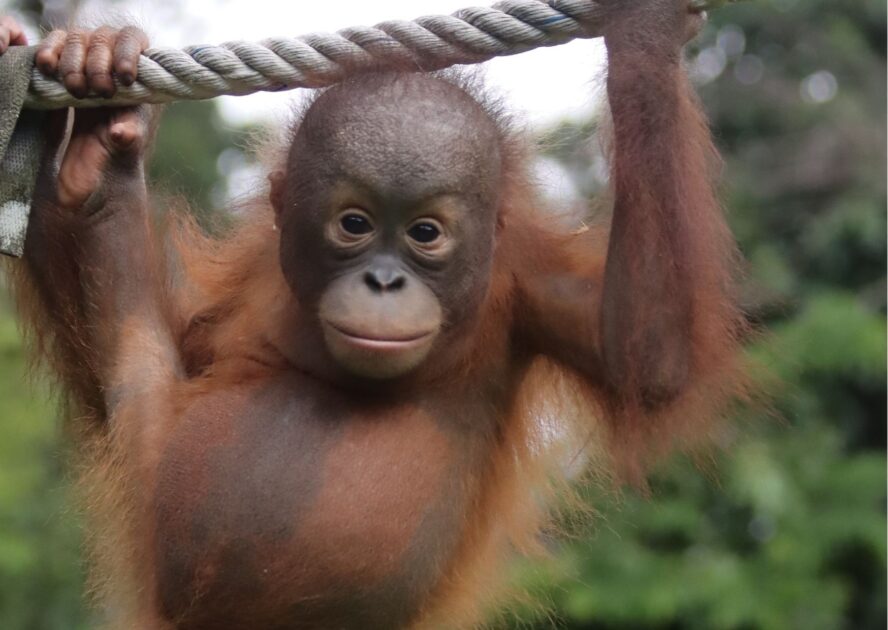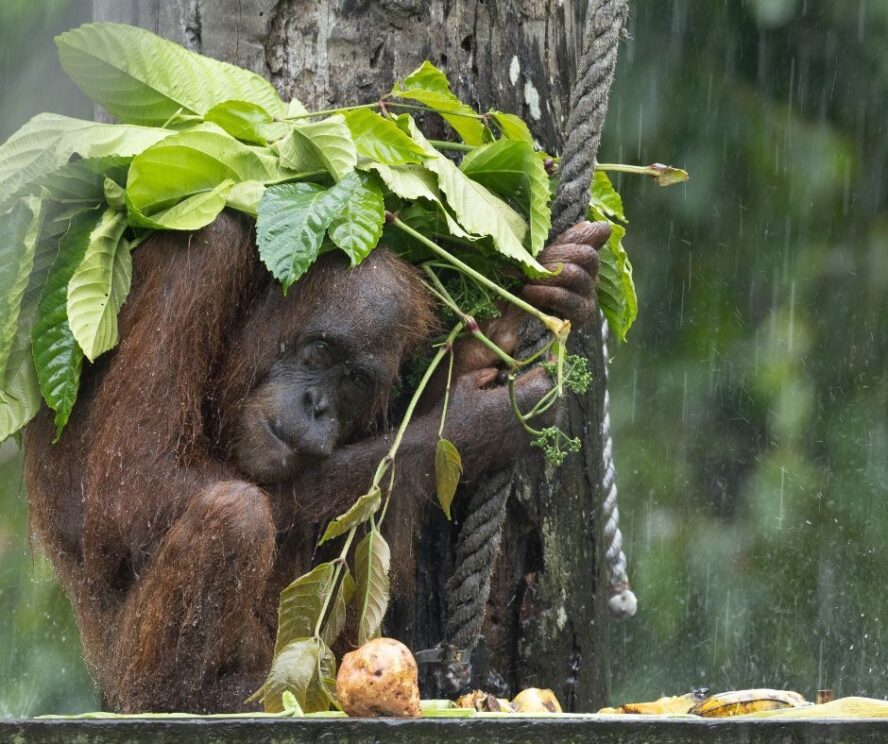News
Fundraising for Post Release Monitoring in Tabin
In 2009, in partnership with Orangutan Appeal UK, the Sabah Wildlife Department recognised the need to better document post release outcomes of released rehabilitated orangutans.
18/02/2014
Executive Summary of the Tabin PRMP
For many decades the department had translocated rescued wild and rehabilitated orangutans into Tabin but there was no effective post release monitoring data available with which to evaluate post release outcomes. With that in mind the decision was taken to launch a pioneering new monitoring programme, and the first field project in the world to use sub cutaneous radio telemetry implants to aid location of released orangutans. The displaced and orphaned orangutans chosen for inclusion on this project have all spent a portion of their early lives at Sepilok Orangutan Rehabilitation Centre where particular skills and character traits such as natural foraging and food processing, locomotion, nest building, independence from humans, and predator avoidance were nurtured prior to release.

Under the leadership of OAUK's primatologist and his team of local Sabahan, the Tabin PRMP has since collected many thousands of hours of never before recorded intensive behavioural data for each released individual. We have released a total of eight individual orangutans in the reserve, and there are plans to release more moving forward. Our long term approach to monitoring is driven by the fact that the truest post release outcomes and the best and most informative research papers are only derived through long-term data collection over many years. This has for so long been severely lacking throughout the whole species range. Indeed, as different release strategies are trialled, and the post release needs of rehabilitant orangutans continue to be identified, it is ultimately expected that this research will contribute to improving the prospects of many reintroduced Great Apes in Africa and Asia. In addition, aside from improving the welfare of the individuals released, this project and others like it have the capacity to diversify the genetic pool of small isolated populations through supplementation, and improve the pre release rehabilitation protocols in use in both Malaysia and Indonesia.

The scope of our activities in Tabin has grown with the increasing number of orangutans we follow as we expand into local schools and communities to deliver environmental education programmes to the next generation of wildlife guardians. We also assist SWD staff in Tabin with patrolling and monitoring the forest and road network in and around the reserve. As we maintain our careful approach to monitoring over the next few years, the expertise we have gained in Sabah makes us a centre of excellence for post release monitoring among great ape reintroduction practitioners. Subsequently OAUK and SWD staff are taking the lead in developing a series of small workshops throughout 2014-16, where, along with other wild orangutan researchers, we aim to share ideas and experiences, communicate results from each of our fields of expertise, and jointly develop methods to improve orangutan rehabilitation in Sabah.

Results so far
Preliminary results demonstrate the need for an interventionist policy of post release management and the importance of employing emerging monitoring technologies that help to facilitate regular contact with all releasees. The requirements of individual animals vary greatly and must be catered to wherever possible to increase long term survivorship. The blanket use of either ‘hard’ or ‘soft’ release strategies across a number of animals is unlikely to be in the best interests of those concerned. Release marks the most challenging aspect of the entire rehabilitation process for great apes; as such, having sufficient boots on the ground to facilitate appropriate intervention where necessary, and working towards establishing some intensive baseline data on post release adaptation, should be considered an ethical requirement of all post release monitoring strategies.
All the female orangutans we are currently following are doing well and gradually making progress toward becoming completely independent. Some are performing better than others, but most generally tend to settle earlier and waste less energy through extensive ranging. Females also show improved diets by consuming more fruits compared to males, who often resort to lower quality fallback foods that are abundant all year round. In May 2013 our efforts in Tabin were rewarded with our first baby born to a released adult female, Otan. Mother and baby Spike continue to thrive as Spike continues into his sixth month. We believe that Otan became pregnant immediately before leaving Sepilok last year. Our lone male in 2012-13, Oscar, struggled. He was one those apes that was just never suitable for independent life without human support. He was very difficult to track and he ranged consistently towards human settlements. His diet was very poor, and on some days he foraged as little as 10%. At the end of 2013 he was thus returned to the care of the Sabah Wildlife Department as life in the wild for Oscar just proved too difficult for him to cope with.
Implications of loss of funding
In Borneo it is estimated that 75% of wild orangutans are found in unprotected and often severely degraded areas. It is thus likely that the number of orangutans arriving to rehabilitation centres will continue to rise in excess of the estimated c. 1300 animals currently housed. Orangutan life history is such that infants and juveniles acquire a vast amount of information and skills through observation and practice from their mothers until c. 5-7 years old. These include foraging and food species recognition, seasonal forest productivity cycles, locomotive techniques, nest-building, predator recognition, and forest navigation. Orphaned orangutans residing in rehabilitation facilities were deprived of this crucial developmental period and are largely incapable of fending for themselves in the wild without some form of preparation for future reintroduction back to their natural habitat. Despite this, it is only through a long term programme of thorough post release monitoring that the success of various rehabilitation protocols can be effectively judged. It may be that we need to dramatically re-evaluate the way we train individuals for future reintroduction. Right now, in 2014, we just don’t know as there is not yet enough collected data on reintroduction outcomes to judge our methods.
Explore more articles
![Orangutan Rescue Stranded Orchard]()
News
Stranded wild orangutan rescued
An orangutan spent nearly three weeks stranded in an orchard miles away from his forest home.
![Napagang 2]()
News
Introducing Napagang
You can help by supporting his rehabilitation at Sepilok and improve his chances of getting back to the wild.
![A female orangutan using leaves to protect herself from the rain.]()
News
Flash floods at Sepilok
Torrential rain has hit Sepilok, causing flash flooding and leaving many areas underwater.


